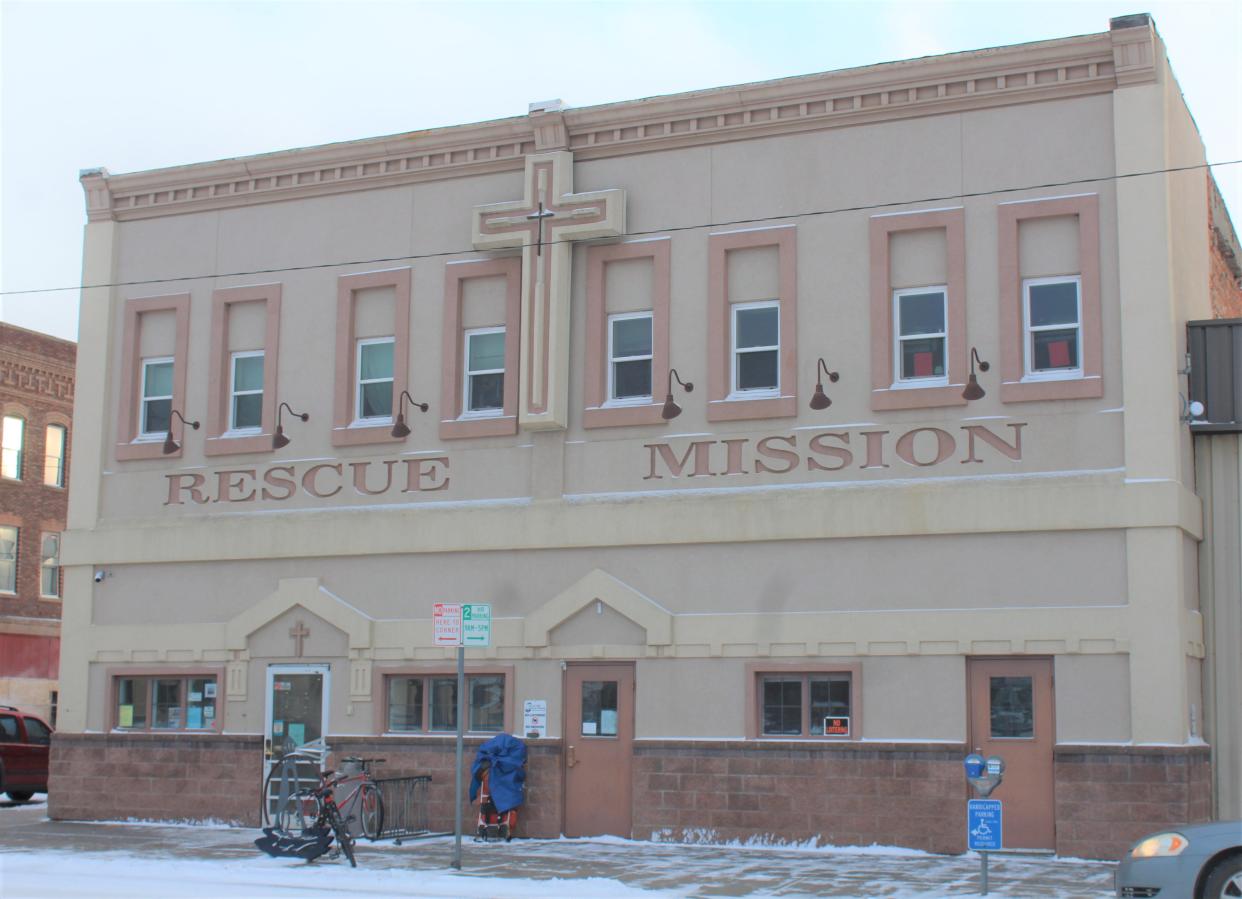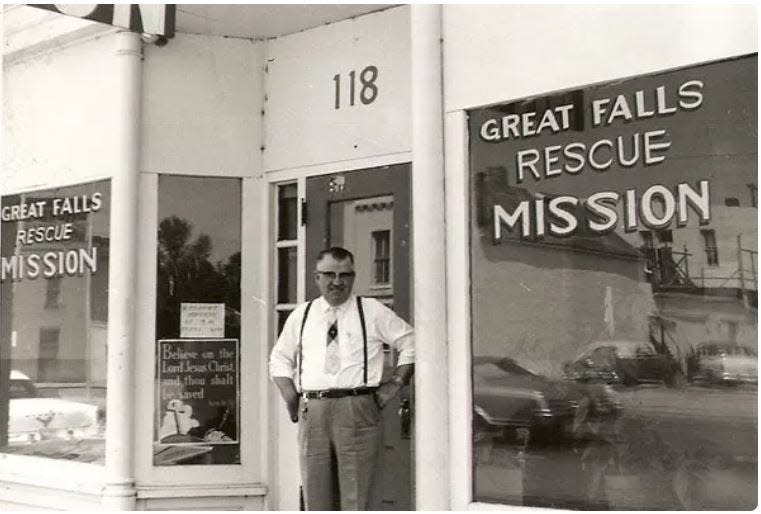Up to 400 homeless find refuge at Rescue Mission shelters during cold snap

On a bitter cold January morning when the thermometer refused to budge above -20, the men, women and families who find shelter at the Great Falls Rescue Mission gave thanks for the refuge it provides
The Great Falls Rescue Mission is not contained within the distinctive building on 2nd Ave. South alone, but includes a complex of three buildings clustered together within a block of the century old building. It’s origins trace back to the vision of a former Montana lumberjack/muleskinner named Harold Ross. In 1963 Ross rented a building within the old “skid row” area of Great Falls where, with the support of local churches, he began ministering to homeless men in Great Falls. In October 1973 he was able to purchase the old Martin Hotel building at 326 2nd Ave. South, which then became the Great Falls Rescue Mission men’s shelter.
A women’s shelter opened in 2005, located at the former Salvation Army Hospitality House directly across the street from the men’s shelter. The mission’s newest addition, the Cameron Family Center, opened its doors to great acclaim in January 2017. Combined, these three facilities represent a unique organization that extends its services to homeless people across 17 Montana counties from the Canadian border, south and east across most of the upper half of eastern Montana.

“There are no other homeless shelters from here all the way to the Canadian border and we kind of share the eastern part of Montana with Billings," explained Carrie Matter, Development Director for the Mission “Our capacity within all three shelters is about 310 occupants."
Temporary residency within any of the Rescue Mission's three shelters comes with conditions, with an emphasis on ensuring the safety and security of the hundreds of occupants and staff who work, eat and sleep there.
"In order to qualify for a bed we require a urinalysis test upon intake," Matter said. "We test for drugs, and we test to see if they’ve been drinking. We do that in order to keep everybody in the building safe. We also have a recovery program in all three of our shelters. We want to honor those residents who are already clean and sober.”
The residency guidelines are relaxed whenever overnight lows drop below freezing. These “cold weather services” allow additional people to take refuge at the men’s and women’s shelters between 10 p.m. and 7 a.m. as long as space is available. Newly arrived mothers with children are welcomed into the Cameron Center beginning at 5:30 p.m. to reduce the likelihood of parents carting their children around town in the dark and cold. Occupants at the men's and women's shelters must leave during daytime hours, but can find shelter at the Great Falls Public Library, the Methodist Church, and St. Vincent de Paul to stay warm.
When daytime temperatures drop below 15-degrees shelter occupants are permitted to remain both day and night. During cold winter nights the population of the Rescue Mission’s three shelters can swell by more than 80 people, pushing up to a maximum capacity of just under 400.
“We try to accommodate as many people as we can with other parts our buildings,” Matter said. “We have a dayroom with couches they can sleep on, and we provide camp mats and blankets so people can sleep on the floor. We just have one simple rule that people have to maintain a respectful attitude, follow the rules, and to check in any bags at the front desk.”
Addressing the core issues of homelessness
While providing overnight shelter to the homeless of central Montana is a critical component of what Great Falls Rescue Mission does, finding ways to get people into permanent housing is the greater goal. Achieving that requires collaboration between a wide range of organizations, businesses, and individuals.
“It isn’t just the Rescue Mission,” said Matter. “It’s our entire community that’s working with the homeless to try and overcome any barriers they may have to finding a home. Sometimes the barrier is criminal one, or maybe there are fines that haven’t been paid. Maybe there’s some housing debt or medical debt … we all work together to try and make sure they are addressing the things that are keeping them from getting into housing.”
“There’s no cookie-cutter situation,” she added. “Our frontline staff are assigned an individual, and the trajectory for each individual varies depending upon their situation. You have to build trust, and also honor their confidentiality. People have to be willing to help themselves too. As you are navigating through all of this at the same time you’re trying to put all those pieces together. You also have to do it in a way that honors them as a human being and as an individual.”
A growing problem in recent years has been the increasing number of homeless with significant mental health problems. Matter said there have been repeated occasions in the recent past when the Rescue Mission has had to deny access to an individual due to safety concerns for the hundreds of other people who occupy the shelters.
"We’re getting individuals from the state hospital who are being released and maybe they were given two- or three-days worth of medication," she described. "They are supposed to have some kind of connection to other services outside of our organization and that’s not necessarily set into place."
“Sometimes, being in a shelter may not be the appropriate place for them," Matter acknowledged. "There are some people with extreme mental health issues the need to be addressed. We try to accommodate them as best we can, but we’re not mental health providers and we’re not medical professionals, so we work very closely with others in order to get them the help they need. We try to do the best that we can. Everybody get's the benefit of the doubt, but sometimes they have to move on. During this weather that makes it extremely difficult."
Matter said the Rescue Mission works with Many Rivers Whole Health, a mental health and life management clinic in Great Falls, as well as the Behavioral Health Center at Benefis Health System to provide services to those with mental health issues. Many Rivers in particular provides a mobile therapeutic support service for adults challenged with a severe, disabling mental illness (SDMI) and need additional support for maintaining successful independent living.
“We have continual conversations with them," she explained. "They come on site with their multi-disciplinary team to perform functional crisis assessments. Sometimes the Many Rivers hospital is literally or behavioral health up at Benefis are the only place these people can go. So, we’re developing good relationships with Benefis and Many Rivers make sure that people are properly assessed before being dropped off here."
A unique, privately funded operation
All this and more, including meals for hundreds of people each day, basic medical care, addiction services and a youth outreach program is done at the Rescue Mission without taxpayer money.
“The majority of the people we serve has experienced trauma in some form or capacity," she added. "Just being homeless in and of itself is traumatic."
"We receive no government funding," she said. "The majority of our funding comes from donations from individuals, private organizations, trusts and grants. We don’t receive any tax dollars to do what we do. That gives us the freedom to help people without them having to qualify for multiple state and federal programs. We want to have the freedom to be able to help as many people as we can."
"The majority of the people that we serve are from Great Falls, Cascade County and all the surrounding counties around us," Matter said. "When it comes down to it, if you’re from Montana we’re all neighbors," Matter said of the Rescue Mission's perspective. "We’re here to help each other.
"If a rural community doesn’t have the resources, naturally they’re going to go to the areas that do have them. Great Falls is a hub. We are the regional medical center for our area. Even if people get stranded, they’re still Montanans. Very rarely will you get individuals who are from out of state, and if you do it could be that they were born in Montana, they went out of state and they’re coming back because it just didn’t work out for them."
Such a program always needs contributions. Food is a special concern.
"It could be things like ground beef, breakfast sausage or milk – things that you would need in your own home," Matter said. "About half the food we serve is donated. That’s from businesses around town and individuals who will bring stuff down.”
Cold weather clothing is also a concern. Woolen hats, gloves, coats, boots and shoes are always welcome - as are twin sized sheets, blankets and pillow cases, shirts and pants in large 2X and 3X sizes, which are especially difficult to get. The Rescue Mission maintains a regularly updated list of their most basic needs at www.gfrm.com
"If people want to donate clothing the largest sizes are what we are in most need of," Matter said. "We ask that people donate either new or like-new items."
This article originally appeared on Great Falls Tribune: Rescue Mission offers relief to homeless during record cold snap

